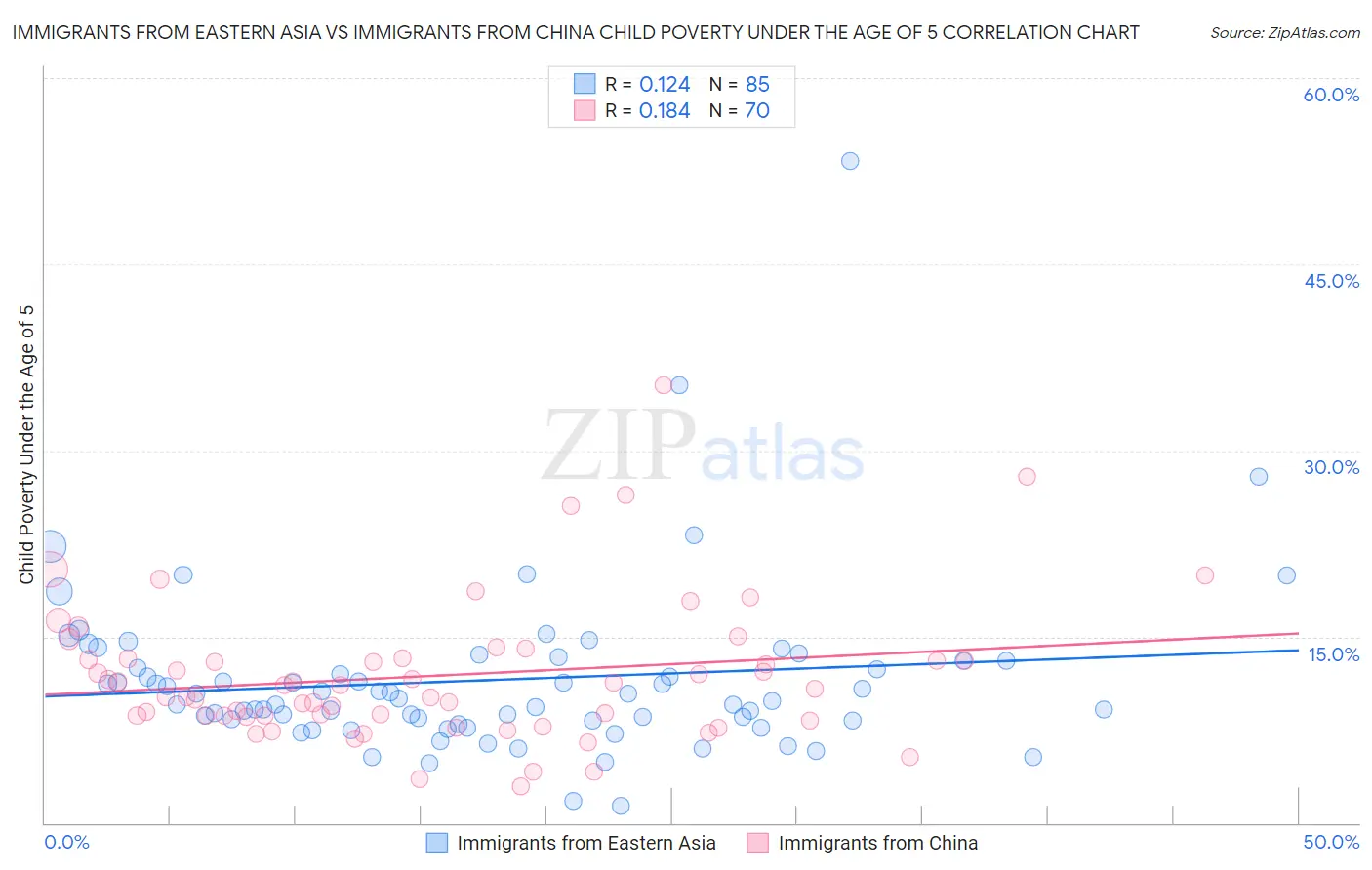Immigrants from Eastern Asia vs Immigrants from China Child Poverty Under the Age of 5
COMPARE
Immigrants from Eastern Asia
Immigrants from China
Child Poverty Under the Age of 5
Child Poverty Under the Age of 5 Comparison
Immigrants from Eastern Asia
Immigrants from China
13.5%
CHILD POVERTY UNDER THE AGE OF 5
100.0/ 100
METRIC RATING
16th/ 347
METRIC RANK
13.6%
CHILD POVERTY UNDER THE AGE OF 5
100.0/ 100
METRIC RATING
18th/ 347
METRIC RANK
Immigrants from Eastern Asia vs Immigrants from China Child Poverty Under the Age of 5 Correlation Chart
The statistical analysis conducted on geographies consisting of 471,993,649 people shows a poor positive correlation between the proportion of Immigrants from Eastern Asia and poverty level among children under the age of 5 in the United States with a correlation coefficient (R) of 0.124 and weighted average of 13.5%. Similarly, the statistical analysis conducted on geographies consisting of 433,139,374 people shows a poor positive correlation between the proportion of Immigrants from China and poverty level among children under the age of 5 in the United States with a correlation coefficient (R) of 0.184 and weighted average of 13.6%, a difference of 0.63%.

Child Poverty Under the Age of 5 Correlation Summary
| Measurement | Immigrants from Eastern Asia | Immigrants from China |
| Minimum | 1.4% | 2.9% |
| Maximum | 53.3% | 35.3% |
| Range | 51.9% | 32.4% |
| Mean | 11.5% | 11.9% |
| Median | 10.0% | 10.9% |
| Interquartile 25% (IQ1) | 8.3% | 8.6% |
| Interquartile 75% (IQ3) | 13.0% | 13.2% |
| Interquartile Range (IQR) | 4.8% | 4.6% |
| Standard Deviation (Sample) | 6.9% | 5.7% |
| Standard Deviation (Population) | 6.9% | 5.7% |
Demographics Similar to Immigrants from Eastern Asia and Immigrants from China by Child Poverty Under the Age of 5
In terms of child poverty under the age of 5, the demographic groups most similar to Immigrants from Eastern Asia are Assyrian/Chaldean/Syriac (13.6%, a difference of 0.34%), Indian (Asian) (13.4%, a difference of 0.51%), Okinawan (13.4%, a difference of 0.57%), Bhutanese (13.4%, a difference of 1.2%), and Immigrants from Ireland (13.7%, a difference of 1.5%). Similarly, the demographic groups most similar to Immigrants from China are Assyrian/Chaldean/Syriac (13.6%, a difference of 0.29%), Immigrants from Ireland (13.7%, a difference of 0.88%), Indian (Asian) (13.4%, a difference of 1.1%), Okinawan (13.4%, a difference of 1.2%), and Immigrants from Japan (13.8%, a difference of 1.3%).
| Demographics | Rating | Rank | Child Poverty Under the Age of 5 |
| Chinese | 100.0 /100 | #7 | Exceptional 13.1% |
| Iranians | 100.0 /100 | #8 | Exceptional 13.1% |
| Immigrants | Iran | 100.0 /100 | #9 | Exceptional 13.1% |
| Burmese | 100.0 /100 | #10 | Exceptional 13.2% |
| Immigrants | Korea | 100.0 /100 | #11 | Exceptional 13.2% |
| Immigrants | South Central Asia | 100.0 /100 | #12 | Exceptional 13.3% |
| Bhutanese | 100.0 /100 | #13 | Exceptional 13.4% |
| Okinawans | 100.0 /100 | #14 | Exceptional 13.4% |
| Indians (Asian) | 100.0 /100 | #15 | Exceptional 13.4% |
| Immigrants | Eastern Asia | 100.0 /100 | #16 | Exceptional 13.5% |
| Assyrians/Chaldeans/Syriacs | 100.0 /100 | #17 | Exceptional 13.6% |
| Immigrants | China | 100.0 /100 | #18 | Exceptional 13.6% |
| Immigrants | Ireland | 100.0 /100 | #19 | Exceptional 13.7% |
| Immigrants | Japan | 100.0 /100 | #20 | Exceptional 13.8% |
| Bolivians | 100.0 /100 | #21 | Exceptional 13.8% |
| Immigrants | Bolivia | 100.0 /100 | #22 | Exceptional 13.8% |
| Bulgarians | 99.9 /100 | #23 | Exceptional 13.9% |
| Asians | 99.9 /100 | #24 | Exceptional 14.0% |
| Cypriots | 99.9 /100 | #25 | Exceptional 14.0% |
| Immigrants | Lithuania | 99.9 /100 | #26 | Exceptional 14.1% |
| Tongans | 99.9 /100 | #27 | Exceptional 14.2% |